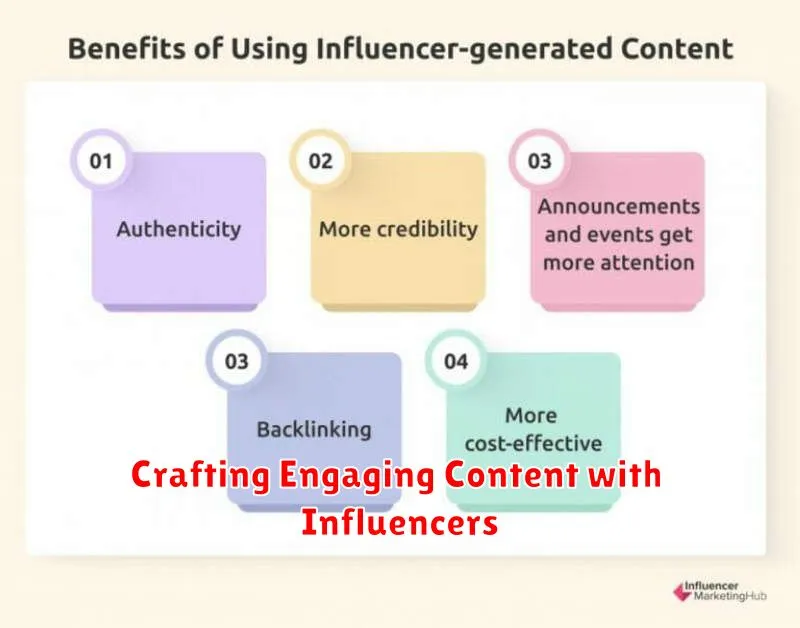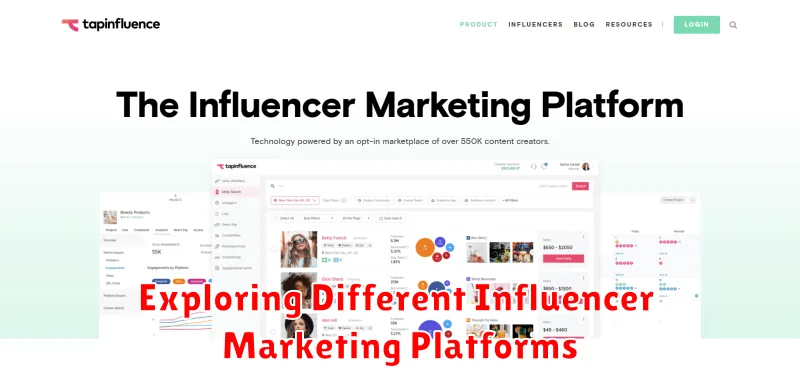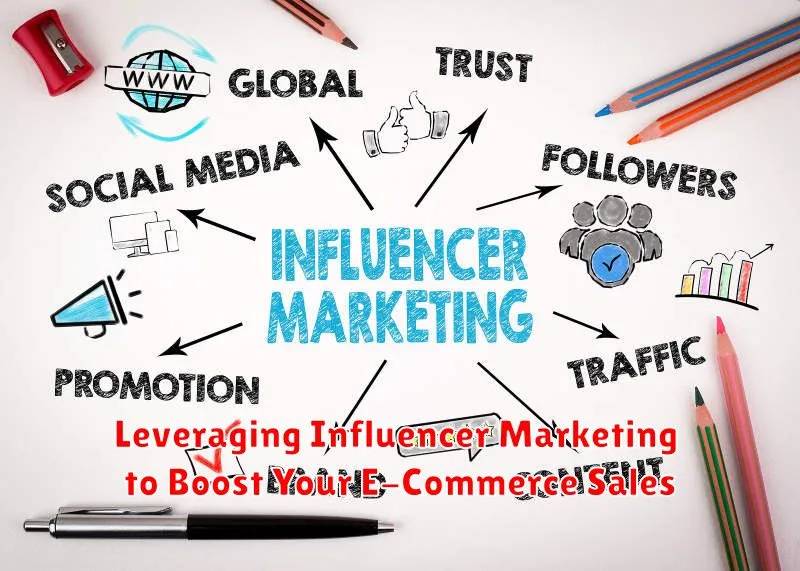In today’s digital landscape, influencer marketing has emerged as a powerful strategy for e-commerce businesses seeking to boost sales and expand their reach. By partnering with relevant influencers, brands can tap into established audiences, build brand credibility, and drive targeted traffic to their online stores. This symbiotic relationship allows businesses to leverage the influencer’s authority and persuasive content to effectively promote products or services to a highly engaged audience, ultimately leading to increased conversions and revenue growth.
This article explores the multifaceted world of influencer marketing and its potential to significantly impact e-commerce sales. We will delve into the key strategies for identifying and collaborating with the right influencers, crafting compelling campaigns, measuring the return on investment (ROI), and maximizing the overall effectiveness of your influencer marketing initiatives. Whether you are new to influencer marketing or looking to refine your existing strategies, this guide will provide valuable insights to help you harness the power of influencer collaborations to achieve your e-commerce sales goals.
Identifying the Right Influencers for Your Brand
Finding the right influencers is crucial for a successful campaign. It’s not just about follower count; it’s about relevance and authenticity.
Start by identifying influencers whose audience aligns with your target demographic. Consider factors like age, gender, interests, and location. An influencer’s audience should genuinely be interested in your product or service.
Next, evaluate the influencer’s engagement rate. High follower counts are meaningless without genuine interaction. Look for influencers with a history of active and engaged followers who comment, share, and like their content.
Finally, consider the influencer’s brand alignment. Their values, aesthetic, and overall image should resonate with your brand. A mismatch can damage your brand’s credibility. Look for influencers who genuinely appreciate your products and whose content naturally aligns with your brand’s message.
Setting Clear Campaign Goals and Objectives
Before launching any influencer marketing campaign, it’s crucial to define specific, measurable, achievable, relevant, and time-bound (SMART) goals and objectives. This provides direction and allows for accurate performance tracking.
Examples of clear goals could include increasing brand awareness, driving website traffic, generating leads, boosting sales, or improving customer engagement.
Clearly defined objectives might involve achieving a specific percentage increase in website visits, acquiring a certain number of new customers, or reaching a target sales revenue within a set timeframe.
By establishing these parameters upfront, you can effectively measure the return on investment (ROI) of your influencer marketing efforts and make data-driven decisions for future campaigns.
Crafting Engaging Content with Influencers

Collaborating with influencers requires a strategic approach to content creation. It’s essential to develop content that resonates with both the influencer’s audience and your brand identity. Authenticity is key. Forced or overly promotional content can damage an influencer’s credibility and negatively impact your brand.
Give influencers creative freedom while ensuring alignment with your campaign goals. Provide them with clear briefs outlining your key messages and objectives, but allow them to adapt the content to their unique style and audience. This fosters more genuine and engaging content.
Consider the type of content that performs best on the chosen platform. Is it short-form video, high-quality images, or in-depth blog posts? Tailor your content strategy accordingly. Variety can also be beneficial. Experiment with different formats to see what resonates most with the target audience.
Finally, incorporate a clear call to action. Whether it’s visiting your website, using a specific discount code, or participating in a contest, guide the audience towards a desired action.
Measuring the Success of Your Influencer Marketing Campaigns
Effectively measuring your influencer marketing campaigns is crucial to understanding their impact and optimizing future strategies. It’s important to establish clear metrics aligned with your campaign goals from the outset.
Key performance indicators (KPIs) will vary depending on your objectives. If your goal is brand awareness, track metrics like reach, impressions, and social media mentions. For driving sales, focus on metrics such as website traffic, conversion rates, and promo code usage.
Utilize trackable links and promo codes to directly attribute sales and website visits to specific influencers. This provides valuable data on which partnerships are driving the most valuable actions.
Regularly monitor your chosen KPIs throughout the campaign. This allows you to identify what’s working, what’s not, and make necessary adjustments in real-time. Analyzing engagement metrics, such as likes, comments, and shares, can also offer insights into audience reception.
Building Long-Term Relationships with Influencers
While one-off campaigns can be effective, building long-term relationships with influencers can yield significantly greater returns. These relationships foster trust and authenticity, allowing influencers to become true advocates for your brand.
Nurturing these partnerships involves ongoing communication and collaboration. Regularly check in with your influencers, offer them exclusive previews of new products or services, and involve them in the creative process.
Mutual benefit is key. Ensure that the partnership is advantageous for both parties. Offer fair compensation, provide creative freedom, and acknowledge their contributions publicly. This fosters a sense of loyalty and encourages continued collaboration.
Consider implementing a tiered system for your long-term influencers, offering increased benefits and opportunities as the partnership grows. This can include exclusive access to events, co-branded merchandise, or even profit-sharing arrangements.
Staying Up-to-Date with Influencer Marketing Trends
The influencer marketing landscape is constantly evolving. Staying informed about the latest trends is crucial for maximizing your return on investment. Actively monitoring these shifts will allow you to adapt your strategies and remain competitive.
Short-form video content continues to dominate, with platforms like TikTok and Instagram Reels leading the charge. Understanding how to effectively leverage these platforms for influencer campaigns is essential.
Authenticity remains a key factor. Consumers are increasingly discerning and can spot inauthentic partnerships. Prioritize working with influencers who genuinely align with your brand and whose audience resonates with your target demographic.
Data-driven analysis is more important than ever. Track key metrics such as engagement rate, reach, and conversions to measure the effectiveness of your campaigns and inform future strategies. Utilize analytics platforms to gain insights into audience demographics and behavior.
Understanding the Legal Aspects of Influencer Marketing
Navigating the legal landscape of influencer marketing is crucial for a successful and compliant campaign. Transparency is paramount. The Federal Trade Commission (FTC) requires clear disclosure of any material connection between a brand and an influencer. This means influencers must clearly and conspicuously disclose when they are being paid, incentivized, or otherwise compensated to promote a product or service.
Disclosure best practices include using unambiguous language like “#ad” or “#sponsored” at the beginning of a post. Simply tagging the brand is often insufficient. Disclosures should be easily visible on all platforms and formats, including video content where verbal disclosure may be necessary.
Contractual agreements are essential. A well-drafted contract outlines the scope of the campaign, deliverables, payment terms, and ownership of content. This protects both the brand and the influencer. Consider including provisions addressing content usage rights, exclusivity, and termination clauses.
Exploring Different Influencer Marketing Platforms

Influencer marketing isn’t confined to a single platform. A multi-platform approach is often necessary to reach diverse audiences. Choosing the right platform depends on your target demographic and the type of product you’re promoting.
Instagram remains a popular choice for visually-driven campaigns, leveraging image and video content. TikTok excels in short-form video content and engaging a younger demographic. YouTube is ideal for longer-form video content, tutorials, and reviews.
Blogs and other written content platforms can provide in-depth product reviews and build trust through thought leadership. Facebook and Twitter, while established platforms, can be effective for driving traffic and building brand awareness.
Niche platforms also play a vital role. Consider platforms like Twitch for gaming products, or Pinterest for visually appealing products and DIY projects. Selecting the right platform mix is crucial for maximizing your campaign’s impact.

